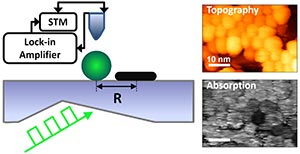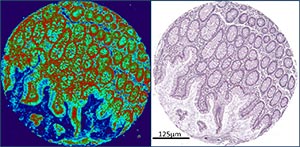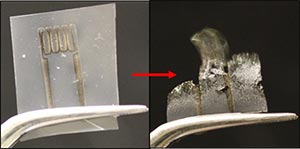Duc Nguyen--Nanoelectronics and Nanomaterials Group
"Imaging Absorption and Intermolecular Energy Transfer Between Single Quantum Dots and Carbon Nanotubes"

We use optically assisted scanning tunneling microscopy (STM) to study laser absorption and intermolecular energy transfer between single quantum dots (QDs) and carbon nanotubes (CNTs). Single PbS QDs and CNTs are deposited onto gold, crystalline silicon carbide (c-SiC) and amorphous silicon carbide (a-SiC) surfaces by matrix-assisted dry contact transfer. Adsorbed molecules are excited with modulated 532 nm light and the modulated tunneling current proportional to the optical absorption signal is detected by STM with a lock-in amplifier. Absorption of individual QDs varies significantly on all surfaces. Single QD absorption is strongly dependent on the sample bias voltage on the gold surface, reflecting different excited states. The dependence is weaker on the c-SiC surface and on the a-SiC surface, where the absorption signal is either dominated by tip heating or substrate absorption. In arrays of QDs, absorbed energy is funneled to one or a few QDs. Evidence of energy transfer between single QDs and single CNTs will also be discussed.
Saumya Tiwari--Bioimaging Science and Technology Group
"Infrared Spectroscopic Imaging Towards Digital Histopathology and Disease Evaluation"

Histopathology is the gold standard for disease diagnosis. Issues arising from experimental variations and inter-observer variability can result in misdiagnosis and increased patient trauma. Infrared spectroscopy can help solve these problems by using inherent bio-chemical contrast in the tissue to develop an automated stain. In the past, clinical use of infrared spectroscopic imaging was limited by speed of acquisition and spatial resolution achieved during imaging. These have been recently addressed through the development of quantum cascade laser instruments and high definition imaging systems. In this talk, I will describe how these latest developments can be translated to clinically relevant models for detection of disease and predicting outcomes.
Hector Lopez-Hernandez--Autonomous Materials Systems Group
"Heat Triggered Transient Electronics"

Polyphthalaldehyde has garnered interest over the past couple of years due to its rapid depolymerization both in solution and solid-state. It has been used as a small signal amplification polymer as well as a substrate for transient electronics. In this work, we investigate the thermal behavior of cyclic polyphthalaldehyde (cPPA). We also developed physically transient electronics which can be destroyed in response to temperatures as low as 80 oC while leaving behind very low polymeric residue (< 2 wt%). Thermogravimetric analysis reveals that cPPA rapidly depolymerizes and evaporates above 150 oC. With knowledge of its acid sensitive backbone, we explored the effect of a thermoacid generator to lower this degradation temperature to as low 75 oC for complete evaporation in 25 min. We demonstrate that cPPA can be used as a degradable substrate for Mg electrodes and as a destructible electrical path in circuits.